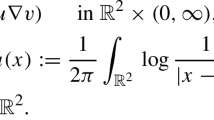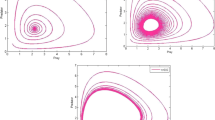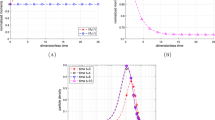Abstract
A delayed Nicholson’s blowflies model with a nonlinear density-dependent mortality term is studied in this paper. Some sufficient conditions are obtained to guarantee the existence and global exponential stability of positive almost periodic solutions of this model. An example with numerical simulations is given to illustrate our main results.
MSC: 34C25, 34K13.
Similar content being viewed by others
1 Introduction
In population dynamics, the classic Nicholson’s blowflies equation developed by Gurney et al. [1] takes the following form:
where denotes the population of sexually mature adults at time t, P is the maximum possible per capita egg production rate, is the population size at which the whole population reproduces at its maximum rate, τ is the generation time, and the mortality rate γ is assumed to be a constant. Such an assumption is reasonable for populations at low densities, but may not be valid any more when the populations are at high densities. A straightforward extension thus assumes that the mortality rate is density-dependent, for instance, Berezansky et al. [2] proposed the following Nicholson’s blowflies equation:
where the nonlinear density-dependent mortality function might have one of the following forms: or with positive constants .
Since variable coefficients and delays in differential equations of population and ecology problems are much more realistic in the real world, (1.1) has been often generalized as follows:
where coefficients and delays are time-varying with or . Moreover, the dynamic behaviors on the existence of positive solutions, periodic solutions, persistence, permanence, oscillation and stability of Nicholson’s blowflies model (1.2) and its analogous equations have been studied extensively. We refer the reader to [3–9] and the references cited therein. On the other hand, the variation of the environment plays an important role in many biological and ecological dynamical systems. Fink [10] and He [11] pointed out that periodically varying environment and almost periodically varying environment are foundations for the theory of nature selection. Compared with periodic effects, almost periodic effects are more frequent. Hence, the effects of almost periodic environment on evolutionary theory have been the object of intensive analysis by numerous authors, and some of these results on Nicholson’s blowflies model without nonlinear density-dependent mortality term can be found in [12–14]. In particular, these results were obtained by using exponential dichotomy theory on almost periodic differential equations or functional differential equations with linear part. However, there is not any linear part in Nicholson’s blowflies model with a nonlinear density-dependent mortality term. Thus, many classical and traditional approaches fail to almost periodic problems on (1.2). Therefore, a new method must be sought to investigate the existence and stability of positive almost periodic solutions of (1.2).
Motivated by the above discussions, in this paper, we employ a novel method to establish some criteria on the existence and global exponential stability of almost periodic solutions for the nonlinear density-dependent mortality Nicholson’s blowflies model given by
where and are almost periodic functions, and .
For convenience, we introduce some notations. In the following part of this paper, given a bounded continuous function g defined on R, let and be defined as
It will be assumed that
Throughout this paper, let denote a nonnegative real number space, be the continuous functions space equipped with the usual supremum norm , and let . If is continuous and defined on with , then we define , where for all .
It is biologically reasonable to assume that only positive solutions of model (1.3) are meaningful and therefore admissible. Much can be learned by considering admissible initial conditions
Define a continuous map by setting
Then f is a locally Lipschitz map with respect to , which ensures the existence and uniqueness of the solution of (1.3) with admissible initial conditions (1.5).
We denote by an admissible solution of admissible initial value problem (1.3) and (1.5). Also, let be the maximal right-interval of the existence of .
Since the function is decreasing with the range , it follows easily that there exists a unique such that
Obviously,
Moreover, since increases on and decreases on , let be the unique number in such that
The remainder of this paper is organized as follows. In Section 2, we give some definitions and lemmas, which tell us that some kinds of solutions to (1.3) are bounded. These results play an important role in Section 3 to establish the existence of almost periodic solutions of (1.3). Here we also study the local exponential stability of almost periodic solutions. The paper concludes with an example to illustrate the effectiveness of the obtained results by numerical simulation.
2 Preliminary results
In this section, we shall first recall some basic definitions, lemmas which are used in what follows.
A continuous function is said to be almost periodic on R if, for any , the set is relatively dense, i.e., for any , it is possible to find a real number with the property that, for any interval with length , there exists a number in this interval such that for all .
From the theory of almost periodic functions in [10, 11], it follows that for any , it is possible to find a real number ; for any interval with length , there exists a number in this interval such that
for all and .
Lemma 2.1 Suppose that there exists a positive constant M such that
Then the set of is bounded, and . Moreover, there exists such that
Proof Let . We first claim:
Suppose, for the sake of contradiction, that there exists such that
It follows that . But
This contradiction means that for all .
For each , we define
We now show that is bounded on . In the contrary case, observe that as , we have
On the other hand,
Thus, in view of the fact that , we get
Letting leads to
which is a contradiction and implies that is bounded on . From Theorem 2.3.1 in [15], we easily obtain .
We next show that there exists such that
Otherwise,
which together with (2.3) implies that
This yields that
Thus
which contradicts with (2.5). Hence, (2.7) holds. In the sequel, we prove that
Suppose, for the sake of contradiction, that there exists such that
Calculating the derivative of , together with the fact that , (1.3), (2.3) and (2.9) imply that
This contradiction yields that (2.8) holds.
We finally show that . By way of contradiction, we assume that . By the fluctuation lemma [[16], Lemma A.1], there exists a sequence such that
Since is bounded and equicontinuous, by the Ascoli-Arzelá theorem, there exists a subsequence, still denoted by itself for simplicity of notation, such that
Moreover,
Without loss of generality, we assume that all , , , and are convergent to , , , and , respectively. This can be achieved because of almost periodicity. Then (1.4) and (2.2) lead to
It follows from
that (taking limits)
a contradiction. This proves that . Hence, from (2.8), we can choose such that
This ends the proof of Lemma 2.1. □
Lemma 2.2 Suppose that (2.2) and (2.3) hold, and
Moreover, assume that is a solution of equation (1.3) with the initial condition (1.5) and is bounded continuous on . Then, for any , there exists such that every interval contains at least one number δ for which there exists satisfying
Proof Define a continuous function by setting
Then we have
which implies that there exist two constants and such that
For , we add the definition of with . Set
By Lemma 2.1, the solution is bounded and
which implies that the right-hand side of (1.3) is also bounded, and is a bounded function on . Thus, in view of the fact that for , we obtain that is uniformly continuous on R. From (2.1), for any , there exists such that every interval , , contains δ for which
Let . For , denote
Then, for all , we get
From (1.7), (2.14), (2.17) and the inequalities
and
we obtain
Let
It is obvious that and is non-decreasing.
Now, we distinguish two cases to finish the proof.
Case one.
We claim that
Assume, by way of contradiction, that (2.23) does not hold. Then there exists such that . Since
there must exist such that
which contradicts (2.22). This contradiction implies that (2.23) holds. It follows that there exists such that
Case two. There is such that . Then, in view of (2.13) and (2.20), we get
which yields that
For any , with the same approach as that in deriving of (2.26), we can show
if .
On the other hand, if and , we can choose such that
which, together with (2.27), yields
With a similar argument as that in the proof of case one, we can show that
which implies that
In summary, there must exist such that holds for all . The proof of Lemma 2.2 is now complete. □
3 Main results
In this section, we establish sufficient conditions on the existence and global exponential stability of almost periodic solutions of (1.3).
Theorem 3.1 Under the assumptions of Lemma 2.2, equation (1.3) has at least one positive almost periodic solution . Moreover, is globally exponentially stable, i.e., there exist constants and such that
Proof Let be a solution of equation (1.3) with initial conditions satisfying the assumptions in Lemma 2.2. We also add the definition of with for all . Set
where is any sequence of real numbers. By Lemma 2.1, the solution is bounded and
which implies that the right-hand side of (1.3) is also bounded, and is a bounded function on . Thus, in view of the fact that for , we obtain that is uniformly continuous on R. Then, from the almost periodicity of a, b, , and , we can select a sequence such that
for all j, t.
Since is uniformly bounded and equiuniformly continuous, by the Arzelá-Ascoli lemma and the diagonal selection principle, we can choose a subsequence of such that (for convenience, we still denote it by ) uniformly converges to a continuous function on any compact set of R, and
Now, we prove that is a solution of (1.3). In fact, for any and , from (3.3), we have
where . Consequently, (3.5) implies that
Therefore, is a solution of (1.3).
Secondly, we prove that is an almost periodic solution of (1.3). From Lemma 2.2, for any , there exists such that every interval contains at least one number δ for which there exists satisfying
Then, for any fixed , we can find a sufficient large positive integer such that for any ,
Let , we obtain
which implies that is an almost periodic solution of equation (1.3).
Finally, we prove that is globally exponentially stable.
Let and , where . Then
It follows from Lemma 2.1 that there exists such that
We consider the Lyapunov functional
Calculating the upper left derivative of along the solution of (3.9), we have
We claim that
Contrarily, there must exist such that
Since
Together with (2.18), (2.19), (3.12) and (3.14), we obtain
Thus,
which contradicts with (2.13). Hence, (3.13) holds. It follows that
This completes the proof of Theorem 3.1. □
4 Example
In this section, we present an example and its numerical simulation to check the validity of results we obtained in the previous sections.
Example 4.1 Consider the following Nicholson’s blowflies model with a nonlinear density-dependent mortality term:
Obviously, , , , , , , , , . Let , from (1.6) and (1.8), we get
and
which implies that the Nicholson’s blowflies model (4.1) satisfies the assumptions of Theorem 3.1. Hence, equation (4.1) has a unique positive almost periodic solution , which is globally exponentially stable with the exponential convergent rate . The numerical simulation in Figure 1 strongly supports the conclusion.
Remark 4.1 To the best of our knowledge, few authors have studied the problems of positive almost periodic solutions of Nicholson’s blowflies delayed systems with nonlinear density-dependent mortality terms. It is clear that the results in [11–13] and the references therein cannot be applicable to system (4.1) to prove the global exponential stability of a positive almost periodic solution. Moreover, one can find that the main results of [17] are restricted to considering the Nicholson’s blowflies delayed systems with the nonlinear density-dependent mortality term and give no opinions about . This implies that the results of the present paper are new and complement previously known results.
References
Gurney MS, Blythe SP, Nisbee RM: Nicholson’s blowflies revisited. Nature 1980, 287: 17–21. 10.1038/287017a0
Berezansky L, Braverman E, Idels L: Nicholson’s blowflies differential equations revisited: main results and open problems. Appl. Math. Model. 2010, 34: 1405–1417. 10.1016/j.apm.2009.08.027
Liu B, Gong S: Permanence for Nicholson-type delay systems with nonlinear density-dependent mortality terms. Nonlinear Anal., Real World Appl. 2011, 12: 1931–1937. 10.1016/j.nonrwa.2010.12.009
Liu B: Permanence for a delayed Nicholson’s blowflies model with a nonlinear density-dependent mortality term. Ann. Pol. Math. 2011, 101(2):123–128. 10.4064/ap101-2-2
Chen W: Permanence for Nicholson-type delay systems with patch structure and nonlinear density-dependent mortality terms. Electron. J. Qual. Theory Differ. Equ. 2012., 2012: Article ID 73. http://www.math.u-szeged.hu/ejqtde/
Wang W: Positive periodic solutions of delayed Nicholson’s blowflies models with a nonlinear density-dependent mortality term. Appl. Math. Model. 2012, 36: 4708–4713. 10.1016/j.apm.2011.12.001
Wang W: Exponential extinction of Nicholson’s blowflies system with nonlinear density-dependent mortality terms. Abstr. Appl. Anal. 2012., 2012: Article ID 302065 10.1155/2012/302065
Chen W, Wang L: Positive periodic solutions of Nicholson-type delay systems with nonlinear density-dependent mortality terms. Abstr. Appl. Anal. 2012., 2012: Article ID 843178 10.1155/2012/843178
Hou X, Duan L, Huang Z: Permanence and periodic solutions for a class of delay Nicholson’s blowflies models. Appl. Math. Model. 2013, 37: 1537–1544. 10.1016/j.apm.2012.04.018
Fink AM Lecture Notes in Mathematics 377. In Almost Periodic Differential Equations. Springer, Berlin; 1974.
He CY: Almost Periodic Differential Equation. Higher Education Publishing House, Beijing; 1992. (in Chinese)
Chen W, Liu B: Positive almost periodic solution for a class of Nicholson’s blowflies model with multiple time-varying delays. J. Comput. Appl. Math. 2011, 235: 2090–2097. 10.1016/j.cam.2010.10.007
Wang W, Wang L, Chen W: Existence and exponential stability of positive almost periodic solution for Nicholson-type delay systems. Nonlinear Anal., Real World Appl. 2011, 12: 1938–1949. 10.1016/j.nonrwa.2010.12.010
Long F: Positive almost periodic solution for a class of Nicholson’s blowflies model with a linear harvesting term. Nonlinear Anal., Real World Appl. 2012, 13: 686–693. 10.1016/j.nonrwa.2011.08.009
Hale JK, Verduyn Lunel SM: Introduction to Functional Differential Equations. Springer, New York; 1993.
Smith HL: An Introduction to Delay Differential Equations with Applications to the Life Sciences. Springer, New York; 2011.
Xu YL: Existence and global exponential stability of positive almost periodic solutions for a delayed Nicholson’s blowflies model. J. Korean Math. Soc. 2014, 51(3):1–21.
Acknowledgements
The author would like to express his sincere appreciation to the reviewers for their helpful comments in improving the presentation and quality of the paper. This work was supported by the construct program of the key discipline in Hunan province (Mechanical Design and Theory), the Scientific Research Fund of Hunan Provincial Natural Science Foundation of P.R. China (Grant No. 11JJ6006), the Natural Scientific Research Fund of Hunan Provincial Education Department of P.R. China (Grants Nos. 11C0916, 11C0915).
Author information
Authors and Affiliations
Corresponding author
Additional information
Competing interests
The authors declare that they have no competing interests.
Author’s contributions
BL finished the work of this paper by himself.
Authors’ original submitted files for images
Below are the links to the authors’ original submitted files for images.
Rights and permissions
Open Access This article is distributed under the terms of the Creative Commons Attribution 2.0 International License (https://creativecommons.org/licenses/by/2.0), which permits unrestricted use, distribution, and reproduction in any medium, provided the original work is properly cited.
About this article
Cite this article
Liu, B. Almost periodic solutions for a delayed Nicholson’s blowflies model with a nonlinear density-dependent mortality term. Adv Differ Equ 2014, 72 (2014). https://doi.org/10.1186/1687-1847-2014-72
Received:
Accepted:
Published:
DOI: https://doi.org/10.1186/1687-1847-2014-72





